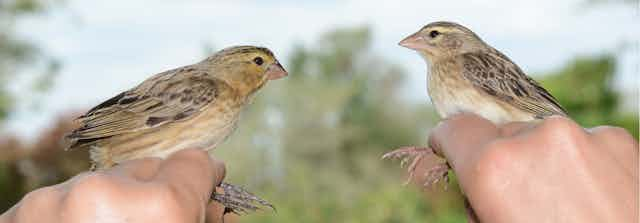Humans are notorious for cheating and deceiving. But we also like to see cheaters get punished. Surprisingly, our research has revealed that the same holds true in the animal kingdom – at least among birds.
We found that African cuckoo finches – brood parasites that rely on a different kind of bird to raise their young – have evolved to look like harmless weaver birds in an attempt to deceive their hosts. But we also discovered that their tawny-flanked prinia hosts have caught onto this and responded by being aggressive to anyone resembling their enemy – a form of collective punishment.
The art of deception
Brood parasites never build their own nests or raise their own offspring. Instead, they lay their eggs in the nests of other birds and abandon the care of their young to the hosts.
The first act of most brood parasite species’ chicks after hatching is to do away with the host’s own brood. Different species do this by ejecting their nest mates from the nest, by using their sharp beaks to fatally injure them, or by physically dominating them.
While hosts obviously do all they can to defend their nests, brood parasites evolve responses to this behaviour. This in turn drives the evolution of better defences in the host, and so on – a process known as an “evolutionary arms race”.
One of the most common strategies for brood parasites to manipulate their hosts into raising their offspring is known as “aggressive mimicry”. This is a way for the birds to dupe a host by looking harmless, for example by resembling a species that is not parasitic.
The strategy is already well-documented in a variety of brood parasite species: some lay eggs that resemble those of their hosts, while the chicks and fledglings of others look (and sound) like the host’s own chicks and fledglings. This is necessary, as hosts will reject parasitic eggs, chicks and fledglings, if they can detect them.
The first challenge for brood parasites is for a female to get her egg into a host nest. Because of this hosts are often very aggressive towards adult brood parasites near their nests. Our research focused on whether natural selection has shaped aggressive mimicry in female brood parasites to help them slip past host defences.
We specifically looked at cuckoo finches, as there is already good evidence of an evolutionary arms race between it and its primary host in southern Zambia, the tawny-flanked prinia.

We were suspicious that adult female cuckoo finches might be employing aggressive mimicry to get into their host’s nest because they look remarkably similar to another group of species that shares their grassy habitats: females of the several common species of weavers, known as bishopbirds or widowbirds. Is this coincidence, or a deceptive strategy shaped by natural selection?
From Tring to Zambia
To answer this question, first we measured and compared the colour and pattern of cuckoo finches’ plumage to those of Vidua finches (the cuckoo finch’s closest relatives) and weavers at the Natural History Museum at Tring, UK.
If female cuckoo finches looked more similar to Vidua finches than to weavers, then it would suggest that the cuckoo finch plumage is a product of their shared ancestry. If they looked equally similar to Vidua finches and weavers, it would suggest that their plumage has been shaped through shared selection pressures from a shared environment (for example, having to avoid shared predators). However, if they looked more similar to the weavers than the Vidua finches, it would suggest that natural selection for mimicry has driven their resemblance.
We found the latter, which suggested that female cuckoo finches have evolved to mimic weavers. We then conducted two field experiments in southern Zambia to test whether we could verify this apparent case of mimicry. This meant months of long days watching these birds from the inside of a hide, which was absolutely brilliant!
Using model cuckoo finches and model southern red bishops (a common weaver species at the study site), we tested whether the prinias reacted differently towards female cuckoo finches and female southern red bishops, compared to male cuckoo finches and male southern red bishops. Unlike females, males of these two species look very different: male cuckoo finches are bright yellow and male southern red bishops are black and red.

Surprisingly, we found that the prinias were extremely aggressive to both the harmful female cuckoo finches and harmless southern red bishops – treating both as threats. They were not, however, aggressive to males of either species.
So were the prinia really deceived by the cuckoo finches’ mimetic plumage? To answer this, we carried out one last experiment. We presented a female cuckoo finch, a female southern red bishop or a male southern red bishop model near a prinia nest. After that, we replaced a prinia egg with an experimental egg to simulate egg laying by a real cuckoo finch.

Just as expected, we found that the prinias were much more likely to reject the foreign egg after seeing one of the two female species than when they saw a male bird. This showed that they were unable distinguish between the two female species and that the cuckoo’s mimicry is successful, but does not give the cuckoo finch the advantage in the arms race at this site.
The analogy of the “wolf in sheep’s clothing” could be helpful here. The prinias recognise the wolf as a threat, but as they are unable to tell wolves from sheep, they respond by punishing all the sheep, just to be safe.
This is unfortunate for the cuckoo finch – and we suspect this is because the rate of parasitism is consistently high at this site, making this strategy worthwhile for the crafty prinias.
Similar to cheating in human society, it seems like the real loser in this situation is the innocent bystander: the unassuming female southern red bishop.

